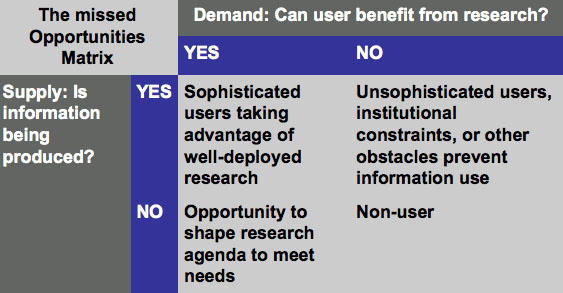Reconciling Supply and Demand - Carbon Cycle ActivitiesMotivationThe goals of the Reconciling Supply and Demand (RSD) - Carbon Cycle activity of the SPARC are to:
ImplementationOur strategy involves combining the ongoing carbon cycle science activities which are compatible with our goals and initiating new ones as well. We will focus on characterizing the demand for carbon cycle information for the first 18 months of this SPARC activity with information on the supply emerging as part of the research activity. Years 2, 3, and 4 will focus on the challenges of reconciliation: characterizing the institutional and cultural barriers, decision-maker constraints, identifying opportunities and building networks. Years 4 and 5 will focus on constructing a theoretical and practical framework for enhancing the component of use-inspired research in this area.
The 2x2 matrix shown above schematically illustrates the process. Areas of positive reinforcement indicate effective resource allocation where sophisticated users are benefiting from relevant science. Areas of negative interference may indicate both opportunities in inefficiencies. Long-term GoalsBy the end of the five-year SPARC project, we hope to have met the following goals:
This project builds on a pilot project on reconciling supply and demand for carbon cycle science funded by the National Oceanic and Atmospheric Administration (NOAA). Results from a workshop in 2004 indicated some successes as well as some key gaps in knowledge on how to create a user-relevant carbon cycle research programs. Our SPARC research is building upon these results to develop a comprehensive, flexible strategy for science policy makers to use in creating user-relevant programs. The 2005 workshop, "Decision Support and Carbon Cycle Science", was held June 13-14, 2005 in Boulder, Colorado. For more information about this project, contact Lisa Dilling. |

